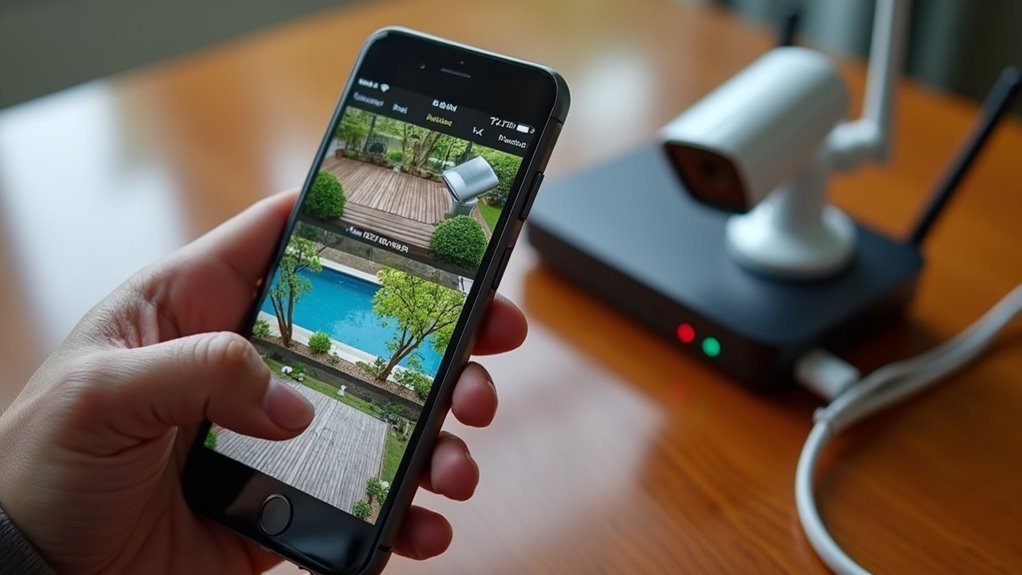You’ve probably experienced the frustration of a smart outlet that suddenly won’t respond to your commands or connect to your network. Whether it’s a complete power failure, intermittent connectivity drops, or unresponsive controls through your app, these devices can fail in multiple ways that’ll leave you scrambling for solutions. Understanding the root causes behind these malfunctions will help you determine whether you’re dealing with a quick fix or a replacement situation.
Common Causes of Smart Outlet Malfunctions

While smart outlets offer convenient home automation, several factors can cause them to malfunction or stop working entirely. Understanding the common causes of smart outlet malfunctions helps you troubleshoot and prevent future issues.
Hardware failures often occur when relay contacts burn out from excessive current draw or mechanical components wear down over time. Your outlet’s hardware version may affect its durability and capacity limits.
Connectivity problems arise from weak WiFi signals, network congestion, or frequent power cycling that disrupts firmware settings.
Power surges and electrical interference can damage internal components, leading to complete failure. Additionally, plugging devices that exceed your smart outlet’s rated capacity can cause operational issues or permanent damage.
Regular monitoring of connected appliances prevents overloading and extends your outlet’s lifespan.
Network Connectivity Problems and Solutions
When your smart outlet won’t respond to commands, you’re likely dealing with WiFi connection failures that prevent the device from communicating with your network.
You can often resolve these issues by resetting your router, which forces the outlet to obtain a fresh IP address and reestablish its connection.
Network problems also stem from IP address conflicts, where multiple devices compete for the same address on your home network.
WiFi Connection Failures
Why does your smart outlet suddenly become unresponsive in the app even though it’s clearly receiving power? WiFi connection failures are typically the culprit behind this frustrating issue.
Network congestion occurs when multiple devices compete for bandwidth on your router, leaving insufficient resources for your smart outlet. Firmware bugs or outdated software can also trigger disconnections, so keeping your device updated maintains stable connectivity.
Changes to your home network—like router relocations, new security settings, or SSID modifications—disrupt your outlet’s WiFi connection. Power cycling your modem or router resolves IP conflicts and network hanging issues.
| Problem | Solution |
|---|---|
| Network congestion | Reduce connected devices or upgrade bandwidth |
| Outdated firmware | Update device software regularly |
| Router changes | Reconfigure network settings |
| IP conflicts | Power cycle modem/router |
Let us know if these solutions restore your connection.
Router Reset Solutions
Router resets offer a reliable solution when basic troubleshooting doesn’t restore your smart outlet’s connectivity.
Power cycling your modem and router clears temporary network glitches that often cause connection failures. Simply unplug both devices for 30 seconds, then reconnect your modem first, followed by your router after two minutes.
Complete router resets provide more thorough router reset solutions by assigning new IP addresses to your smart outlet, eliminating conflicts that disrupt connectivity.
Before resetting, update your router’s firmware to prevent network instability that affects smart devices. After reset, verify your security settings remain compatible with your outlet’s requirements.
Additionally, evaluate your outlet’s distance from the router, as weak signals from physical obstacles or excessive distance create persistent connection problems requiring repositioning.
IP Address Conflicts
IP address conflicts frequently disrupt smart outlet functionality by creating network chaos when multiple devices compete for the same digital address.
When your router’s DHCP exhausts its available IP range, new devices can’t connect properly, leaving your smart outlets offline.
You’ll need to restart your router to refresh DHCP leases and reassign unique addresses to all connected devices. This simple action often resolves most IP address conflicts immediately.
For persistent issues, consider configuring static IP addresses for your smart outlets through their settings, ensuring they’ll always claim the same network spot.
Monitor your router’s admin panel to identify conflicting devices and track network traffic patterns. This proactive approach helps you spot problems before they knock your smart outlets offline again.
Hardware Failures and Component Issues
When smart outlets fail to function despite proper network connectivity and configuration, the issue often lies within the device’s internal hardware components.
These hardware failures typically stem from mechanical deterioration of internal relays after extensive use, preventing power delivery to connected devices.
High-current appliances like 3D printers can cause burnt contacts or damaged relays within your smart plug.
You’ll also encounter problems from solder issues or burned traces on the high-power side, creating intermittent or complete failures.
Always respect your smart plug’s electrical specifications—commonly rated at 12 amperes.
Exceeding this limit causes overheating and subsequent hardware failure.
Additionally, internal components like relay grippers may fail to maintain secure contact with plug pins, rendering your device completely non-functional despite appearing physically intact.
Power and Electrical Problems

Beyond internal component degradation, electrical supply issues frequently disrupt smart outlet functionality and create frustrating performance problems.
Power surges or overloads exceeding your device’s 12-amp capacity can damage critical components like relays and circuits, causing permanent failure.
You’ll encounter power and electrical problems when circuit breakers trip or fuses blow, cutting off electricity until you reset them.
Poor wiring connections create inconsistent power delivery, making your smart outlets work intermittently.
Damaged electrical outlets compound these issues by preventing reliable current flow.
Power cycling your devices frequently or leaving them inactive for extended periods can also compromise their reliability, especially if they’re not designed for such usage patterns.
Firmware and Software Related Issues
Your smart outlet’s firmware and software can become the root of persistent performance problems when files get corrupted or updates fail to install properly.
You’ll often notice these issues manifest as connectivity drops, unresponsive controls, or complete device malfunctions that seem to have no clear hardware cause.
App connectivity glitches frequently compound these problems, creating a frustrating cycle where your outlet won’t respond to commands or maintain stable connections to your home network.
Corrupted Firmware Files
Although smart outlets are designed for seamless operation, corrupted firmware files can transform these convenient devices into unresponsive frustrations. When updates get interrupted or fail completely, you’re left with firmware that can’t properly control your outlet’s functions.
| Symptom | Cause | Solution |
|---|---|---|
| No response to commands | Interrupted firmware update | Factory reset device |
| Intermittent connectivity | Network incompatibility | Update firmware completely |
| Device won’t power on | Completely corrupted files | Replace or reflash firmware |
| Random disconnections | Partial corruption | Reset and reconfigure |
You’ll notice unpredictable behavior when corrupted firmware files take hold. Your outlet might ignore voice commands, fail to connect to your network, or operate sporadically. Regular firmware updates prevent these vulnerabilities, but factory resetting often becomes necessary to clear corrupted data and restore proper functionality.
Failed Software Updates
When software updates go wrong, your smart outlet can transform from a reliable home automation device into a paperweight.
Failed software updates occur when firmware installations get interrupted or incomplete, preventing your device from functioning properly. You’ll notice your outlet becoming unresponsive or unable to connect to WiFi networks after these botched updates.
Many users experience this frustration when manufacturers push automatic updates that create compatibility issues. Your previously working smart plug might suddenly stop responding to commands or lose network connectivity entirely.
Fortunately, you can often resolve failed software updates by performing a factory reset and reconfiguring your device through its app.
To prevent future issues, regularly check for firmware updates and verify you’re running the latest software versions on your smart outlets.
App Connectivity Glitches
App connectivity glitches represent one of the most common culprits behind smart outlet malfunctions, often stemming from firmware mismatches between your device and mobile application.
When your smart outlet’s firmware becomes outdated, it can’t properly communicate with updated apps, leaving your device unrecognized on your network.
You’ll likely encounter app connectivity glitches when your home network undergoes changes like installing a new router or modifying settings.
These disruptions break the established connection protocols your smart outlet relies on.
Corrupted app data compounds these issues, preventing effective communication between components.
You’ll need to completely reinstall the app to restore functionality.
Additionally, interference from other 2.4GHz devices can disrupt signal strength, causing persistent connectivity problems that require troubleshooting your network environment.
Troubleshooting Steps to Restore Functionality
Before diving into complex solutions, start with the most basic check: verify that your smart outlet’s physical power button is switched to the “On” position.
Manually test the button to confirm it’s working properly. Next, power cycle your modem and router to assign a new IP address and restore WiFi connectivity.
If connectivity issues persist, perform a factory reset following your manufacturer’s instructions to clear software glitches.
Check all wiring connections and test the outlet with a different device to confirm it’s functioning correctly.
These troubleshooting steps to restore functionality address most common problems.
If your outlet remains unresponsive after these attempts, consider warranty options or replacement, as mechanical failures can occur after extended use.
Frequently Asked Questions
Why Have My Smart Plugs Stopped Working?
Your smart plugs likely stopped working due to WiFi connectivity issues, overloaded circuits exceeding their 12A capacity, mechanical relay failure, outdated firmware, or external disruptions like power outages affecting your network connection.
Why Did All My Smart Plugs Go Offline?
Your smart plugs likely went offline due to WiFi connectivity issues, power outages disrupting network reconnection, or firmware problems. Check your router’s stability, restart the plugs, and verify they’re receiving adequate power signals.
How Do I Reset My Smart Outlet?
You’ll find a reset button on your smart outlet – hold it down for 10-15 seconds until the light flashes. If there’s no button, unplug it for thirty seconds, then reconnect.
How Do I Get My Smart Plug Back Online?
You’ll need to guarantee your appliance’s hardware button is on and power cycle your router. Reset the smart plug following manufacturer instructions, test different outlets, and check for firmware updates through the app.





Leave a Reply